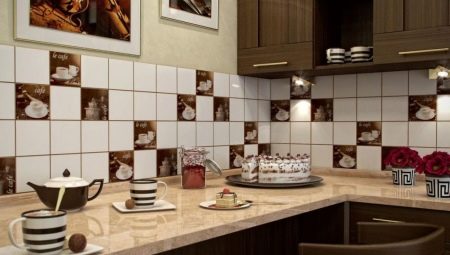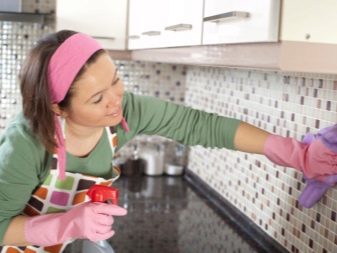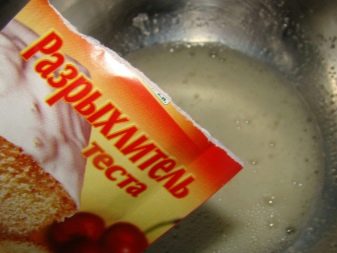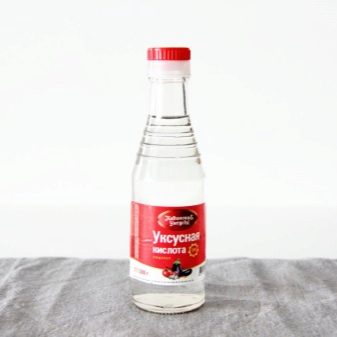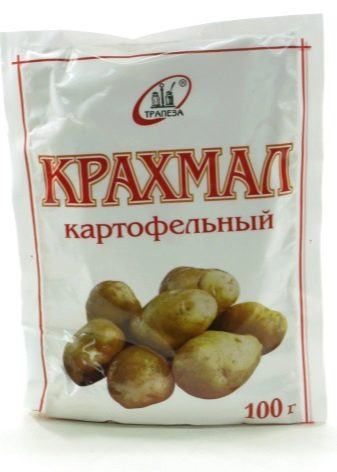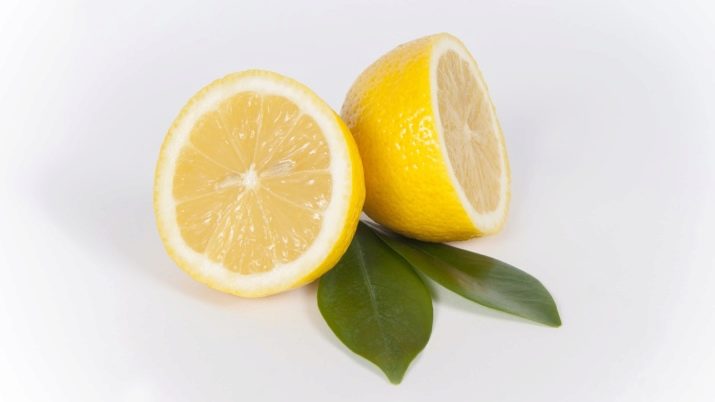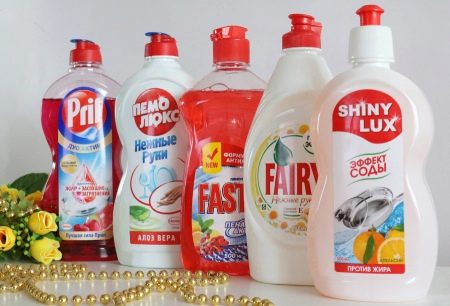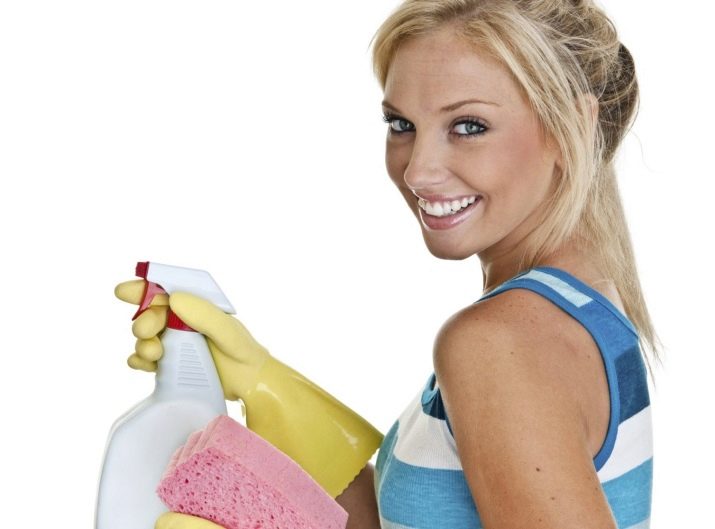Contamination of tiles occurs in the process of cooking. The most susceptible to the formation of greasy stains in the kitchen, equipped with gas stoves with an open flame, and to a lesser extent - the rooms in which electric stoves and cooking panels are installed. To maintain cleanliness and keep the room in perfect condition helps regular and competent care for the tiled surface.
General recommendations
To ensure that ceramic tile always looks clean and the kitchen is well-groomed, it is necessary to wipe the areas adjacent to the stoves daily. This will avoid the formation of old and large areas of pollution. Wash tiles need a soft cloth or sponge. The use of metal nets due to the risk of scuffing and scratching is not recommended. For daily processing, you can use a soap solution, dishwashing detergent or a wiper. If a detergent is used, it must be warmed up before use. This will contribute to a better cleaning of the surface and will require less effort. Before starting work, wear rubber gloves.
If it was not possible to clean the fat stains with one tool, then before using another, it is necessary to completely wash off the previous one. This will help avoid the occurrence of unpredictable chemical reactions that can damage the tile.
Cleaning the tile is better to start from the bottom rows, and clean washing - from the top. The floor in such cases is covered with thick paper. This will prevent its contamination with particles of fat and protects against ingress of chemicals. After cleaning with the use of synthetic means, it is recommended to ventilate the room.
Special attention should be paid to the tile joints. They are cleaned by the same means as the tile, but using a narrow stiff brush. After processing, you need to gently wipe each seam with alcohol or acetic essence. This will help prevent the occurrence of fungi, mold and pathogens. When removing old stubborn dirt, apply a splitting agent on the stain and leave for 10 minutes. Then, using a wooden scraper, you need to remove the dirt and begin to launder tile special means.
With strong and old dirt can be applied steam treatment method which is carried out using a steam generator. In the working capacity of the unit, pour a special detergent and turn on the heat. After the temperature of the liquid reaches 150 degrees, the unit will begin to produce steam under high pressure. This method will effectively degrease the wall and ceiling tiles and carry out its full disinfection.
Home remedies
It is possible to carry out high-quality cleaning of ceramic tiles with the help of common household products that effectively cope with fatty contaminations and do not cause allergic reactions.
The most common ingredient is baking soda. To get rid of grease stains, it is enough to dilute three tablespoons of this product in one liter of warm water, and, wetting a sponge in this solution, process the contaminated surface. Soda perfectly breaks down the fat and whitens the tile joints well.. A very effective tool is a mixture of soda, citric acid and starch. The resulting composition should be applied to a damp sponge and wipe the tiles.
Caustic soda also effectively copes with grease stains.It is enough to dissolve it in water to obtain a mushy mass, at the rate of 150 g per glass, and apply a thick layer on the stain. After two or three minutes, you need to remove the gruel using a napkin soaked in vinegar.
This procedure will allow you to completely clean the tile of fat, making a minimum of physical effort. It must be remembered that the treatment of soda should be carried out in the form of its solutions. Due to its abrasive structure, cleaning with a dry substance can lead to scratches and abrasion of the tile surface.
Hostesses follow a closer look at citric acid. The simplest and fastest way to break down fat is to use a lemon wedge. It is enough to wipe the contaminated surface with it, and wait a few minutes. Fat will be collected in lumps, after which it will be easily removed with a damp cloth. A mixture of citric acid and soda is also effective. Both components must be diluted in a small amount of water, then applied to the stain and left for five minutes. Then rinse with clean water.
Acetic essence should be in every home. For fresh dirt, moisten the cloth in a weak solution of vinegar, apply on the contaminated surface and leave for 15 minutes. After that, rinse with water and wipe dry with an absorbent cloth. You can also make a mixture of mustard and vinegar. Substances are mixed to a mushy consistency and applied to the stain. After 5-10 minutes, the product is washed off. In addition to cleaning the surface, vinegar adds shine to the tile and refreshes the paint.
Ammonia perfectly breaks down fat. For surface treatment, it is necessary to dilute three tablespoons of alcohol in a glass of water, pour the resulting solution into a spray bottle and spray it on to contamination. After 15-20 minutes, the composition should be washed with warm water. If the contamination is old and eaten, then neat alcohol is used. It is applied to the stain and left for some time. After the fat is split, the dirt must be removed with a brush and rinsed with water.
Mustard powder copes well with grease and gives the tile a freshness and shine. To process ceramic tiles, it is necessary to dilute the powder in water to a mushy state and apply it on a greasy stain. After 10 minutes, the mixture must be removed and the tile washed thoroughly.
Baking powder dough is used to remove fat, as it has soft abrasive properties. It includes soda, which, in addition to cleansing, gently whitens the surface.
Vegetable oil will also help clean the tile from grease stains. To do this, just put it on the contaminated surface and leave for 15-20 minutes. After that, the fat is easily removed with a regular sponge.
Household chemicals
Despite the fact that household formulations are safe and widely available, many prefer to use household chemicals. The use of ready-made products eliminates the need for self-preparation of various detergent compositions, they are quite effective and smell good. Cleaning of tiles should be done only by means intended for this. It is not recommended to treat with a liquid for stainless steel, a stove or an abrasive. The use of gels containing acids is also prohibited. The acid will corrode the tile joints and damage the smooth surface.
Along with special means for washing ceramic tiles, it is allowed to use dishwashing liquids and windows. Before applying the composition should read the instructions: some funds must be applied to the surface and leave for a certain time.
In the case of allergic reactions to chemical compounds, you need to purchase environmentally friendly gels with vegetable or mineral base. The use of a spray gun allows you to economize the liquid and contributes to its more convenient application to the tile. The most famous means for washing tiles are "Sanit", "Mr. Muskul" and "Silith Beng".
The final stage of cleaning tiles is to give it a pristine shine. This is achieved by treating clean tile with a wiper or mirror fluid. From home remedies you can use a mixture of water with ammonia, taken in equal amounts. It is also recommended to dilute a weak solution of acetic essence or use polishing wax. A large variety of household and folk tile cleaning products can effectively remove grease and keep the kitchen clean.
For information on how to achieve crystal clear tiles in the kitchen, see the following video.
